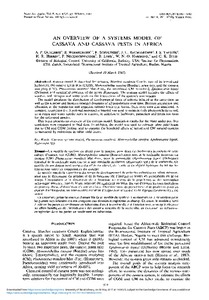| dc.contributor.author | Gutierrez, A.P. |
| dc.contributor.author | Wermelinger, B. |
| dc.contributor.author | Schulthess, F. |
| dc.contributor.author | Baumgärtner, J.U. |
| dc.contributor.author | Yaninek, J.S. |
| dc.contributor.author | Herren, H.R. |
| dc.contributor.author | Neuenschwander, P. |
| dc.contributor.author | Lohr, B. |
| dc.contributor.author | Hammond, W.N.O. |
| dc.contributor.author | Ellis, C.K. |
| dc.date.accessioned | 2020-08-18T09:11:59Z |
| dc.date.available | 2020-08-18T09:11:59Z |
| dc.date.issued | 1987 |
| dc.identifier.citation | Gutierrez, A.P., Wermelinger, B., Schulthess, F., Baumgärtner, J.U., Yaninek, J.S., Herren, H.R., ... & Ellis, C.K. (1987). An overview of a systems model of cassava and cassava pests in Africa. International Journal of Tropical Insect Science, 8(4-6), 919-924. |
| dc.identifier.issn | 1742-7584 |
| dc.identifier.uri | https://hdl.handle.net/20.500.12478/6944 |
| dc.description.abstract | A systems model is described for cassava, Manihot esculenta Crantz, two of its introduced herbivores, the cassava green mite (CGM), Mononychellus tanajoa (Bondar), sensu lato, and the cassava mealybug (CM), Phenacoccus manihoti Mat.-Ferr., the introduced CM parasitoid, Epidinocarsis lopezi (DeSantis) and coccinellid predator of the genus Hyperaspis. The systems model includes the effects of weather, soil nitrogen and water levels on the interactions of the system’s components. The model simulates the distribution of developmental times of cohorts initated at the same time, as well as the number and biomass (energy) dynamics of all populations over time. Biomass acquisition and allocation at the population and organism subunit levels (e.g. leaves, fruit, ova) were also simulated. A common acquisition (i.e. functional response) submodel was used to estimate daily photosynthetic as well as nitrogen and water uptake rates in cassava, in addition to herbivory, parasitism and predation rates for the arthropod species. This paper presents an overview of the systems model. Simulation results for the plant under pest free conditions were compared to field data. In addition, the model was used to estimate tuber yield losses due to CM and CGM feeding, and to examine the beneficial effects of introduced CM natural enemies as measured by reductions in tuber yield losses. |
| dc.format.extent | 919-924 |
| dc.language.iso | en |
| dc.subject | Cassava |
| dc.subject | Phenacoccus Manihoti |
| dc.subject | Mononychellus Tanajoa |
| dc.subject | Epidinocarsis Lopezi |
| dc.subject | Hyperaspis |
| dc.subject | Africa |
| dc.subject | Systems |
| dc.subject | Models |
| dc.subject | Simulation Models |
| dc.title | An overview of a systems model of cassava and cassava pests in Africa |
| dc.type | Journal Article |
| cg.contributor.crp | Roots, Tubers and Bananas |
| cg.contributor.affiliation | University of California |
| cg.contributor.affiliation | International Institute of Tropical Agriculture |
| cg.contributor.affiliation | Institut fur Phytomedizin, Switzerland |
| cg.coverage.region | Africa South of Sahara |
| cg.identifier.bibtexciteid | GUTIERREZ:1988a |
| cg.isijournal | ISI Journal |
| cg.authorship.types | CGIAR and advanced research institute |
| cg.iitasubject | Agronomy |
| cg.iitasubject | Cassava |
| cg.iitasubject | Disease Control |
| cg.iitasubject | Food Security |
| cg.iitasubject | Pests of Plants |
| cg.iitasubject | Plant Breeding |
| cg.iitasubject | Plant Diseases |
| cg.iitasubject | Plant Health |
| cg.iitasubject | Plant Production |
| cg.journal | International Journal of Tropical Insect Science |
| cg.notes | Published online: 01 Dec 1987 |
| cg.accessibilitystatus | Limited Access |
| cg.reviewstatus | Peer Review |
| cg.usagerightslicense | Copyrighted; all rights reserved |
| cg.targetaudience | Scientists |
| cg.identifier.doi | https://dx.doi.org/10.1017/S1742758400023195 |
| cg.iitaauthor.identifier | Peter NEUENSCHWANDER: 0000-0003-0580-0376 |

